I remember when I first saw a video of a glassblower, and I decided that I wanted to be just like him when I grew up. There’s something about beautiful, artful glass that catches the eye of even the most casual observer. Some of the most beautiful glass in the history of the world was created by Fenton Art Glass throughout the 20th century.
Fenton Glass was made between the years of 1905-2011 when they ceased traditional glassmaking operations. For most of that time, they were based out of Williamstown, West Virginia. Fenton Art Glass chose to make all of their products inside the USA, using American instead of foreign artisans.
In this article, we’ll look at the history of Fenton Glass, discuss what Fenton Glass is like today, and answer some commonly asked questions about Fenton Glass.
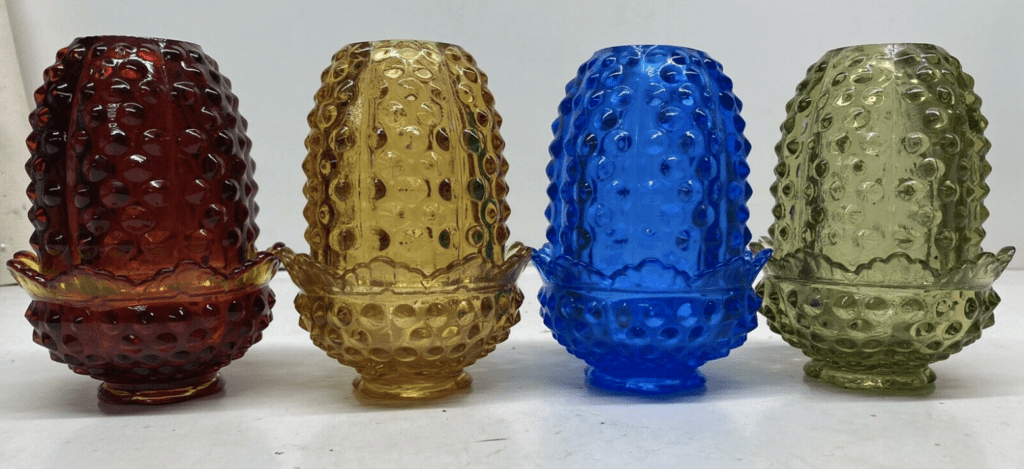
The History of Fenton Glass
Fenton Art Glass started off as a glass decorating company. Founded in 1905 in Ohio by John and Frank Fenton, Fenton Art Glass was inspired by other glassmakers at the time, such as Tiffany and Steuben. Both of these companies produced luxurious glass for the wealthy upper class. The Fentons wanted to produce similarly beautiful glass, but make it more affordable for average families. This is exactly what they did.
Fenton Glass quickly became popular, to the point that in 1907, the Fentons decided to begin producing their own glass, instead of simply decorating glass. They moved from Ohio to West Virginia. They started with carnival glass, which helped them start off with a bang. Then, in the 1920s, they hired European artists to produce handmade paintings on glassware, creating uniquely beautiful, one-of-a-kind pieces.

With these strategies, they had incredible success from their beginning up until the 1940s, when the Great Depression hit. Most glass companies shut down during this time, but Fenton was able to survive by adapting their business model—instead of making high-quality or artistic glassware, they shifted to making more essential, everyday products like dinnerware.
This type of glassware is sometimes known as “depression glass” (see FAQ section for more on depression glass). After WWII and the end of the Depression, they returned to making high-quality glassware until 2011, when they ceased traditional glassmaking operations.
Where was Fenton Made?
From the start, Fenton was an American company. As mentioned above, Fenton Art Glass was founded in Ohio before moving to West Virginia in 1907. All of Fenton’s glass pieces were made in the USA. Fenton opted to go with American artisans for all of their work, and have kept this tradition throughout their history, always hiring in-house in the USA. Even through the “Made in China” boom of the late twentieth century, Fenton continued to maintain their operations in the USA.
Did Fenton go out of Business?
Sales began to slow for Fenton in the 90s and 2000s. They had originally planned to stop operations in 2007 due to economic difficulties, but after a boom in sales, they decided to stay open and give it one more try. They survived off of the boom for a few years but eventually ceased glassmaking operations in 2011.
Although they ceased to make glassware as before, Fenton continues to make jewelry with smaller pieces of luxury glass to this day. You can check out their current website to see some of their jewelry.
Is Fenton Still Being Made?
Kind of. Fenton Art Glass ceased making art glass in 2011. However, a branch of Fenton was able to continue based on the sales numbers: Fenton Glass Jewelry. Fenton Glass Jewelry continues to this day to produce high-quality jewelry with glass beads and other decorations.
Is Fenton Glass Still Operating?
Kind of. Fenton Glass Jewelry was purchased in 2015 by John Barton Company. They continue operations as a glass bead jewelry-maker, and have their own website as well (see link above).
Where is Fenton Glass Made Today?
Fenton Glass continues to be made in the USA, and there’s no sign of that changing anytime soon. Currently, Fenton Glass Jewelry is made in Ohio, though it is sold in multiple places, particularly on their website.
Who Makes Fenton Glass Now?
Fenton Glass Jewelry was bought in 2015 by John Barton Company, which currently runs its operations as a parent company. Fenton Glass Jewelry continues its tradition of utilizing local artisans. Though with a much simpler job now that most of their work produces simple beads instead of intricate designs, Fenton Glass continues to be some of the most refined in the world.
Can You Still Buy Fenton Today?
In short: Yes. Although Fenton Glass is no longer being produced, you can still buy Fenton art glass. A simple Google search will bring up a wide variety of options. We recommend buying from Etsy if you’re okay with an independent seller. Otherwise, you can also find auctions where Fenton Glass is being sold, though nowadays, most of these will be online as well. Unless you’re looking for a specific, rare piece, odds are that you’ll find something that you like online.
Where Was Fenton Glass Located?
Fenton Glass was originally founded in Martins Ferry, Ohio. During their time in Ohio, Fenton Glass was primarily a glass decorating company, not having yet evolved to producing their own glass. With a quick rise in demand, and increasing popularity, Fenton Glass relocated to Williamstown, West Virginia. This is where they continued their business until 2011 when they stopped glassblowing operations.
What is so Special about Fenton Glass?
Fenton Glass is revered for a number of reasons. Fenton was the largest manufacturer of handmade glass in the United States for over 100 years. During this time, they produced over 130 unique patterns.
Fenton Glass is renowned for its handmade quality. Immediately after the Industrial Revolution, where most companies were relying on machinery and mechanical processes for production, Fenton continued to make handmade glass. Since anything handmade was becoming more rare in the twentieth century, Fenton became unique for their high-quality handmade glassware. Today, handmade products are even more rare, so Fenton Glass is increasingly valued.
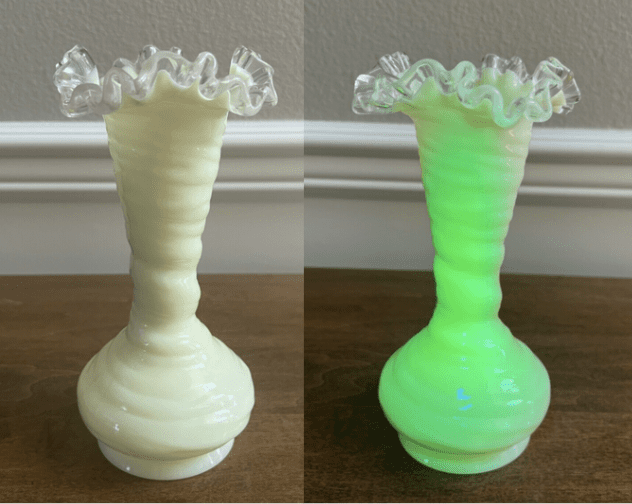
As a note here, handmade glass and handblown glass refer to two different things. Fenton did not make handblown glass, though they did continue to make handmade glass. See the FAQ section for more detail.
Fenton Glass is also special because of its innovative glass colors. Fenton is known for many colors. Their white-milk glass hobnail has been described as their bread-and-butter, especially during the 50s and 60s in the post-war years. During this time, their opalescent green, blue, pink, and red glass were all popular as well. These were affordable pieces that were also beautiful. Shortly thereafter, in the 60s, transparent colors became increasingly popular. Fenton is also known for other gorgeous and rare patterns, like their diamond lace patterns, and cranberry glass, which is still a sought-after item on the market today.
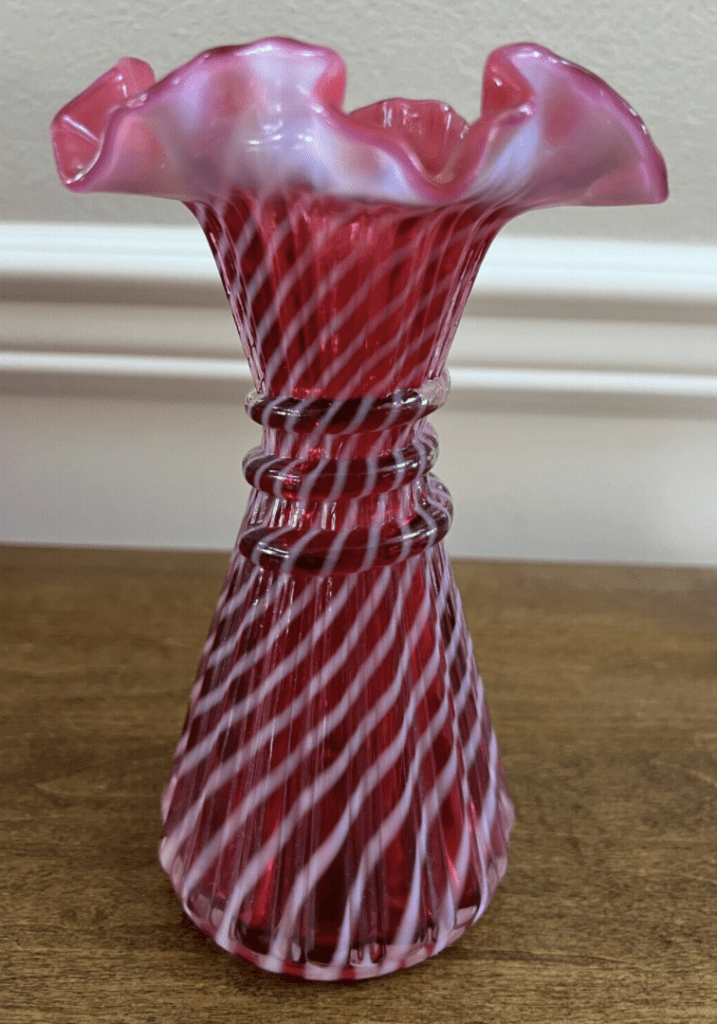
When was Fenton Glass Popular?
Fenton Glass was popular for almost an entire century, during practically the entire time that it was being made. Even when John and Frank Fenton were only decorating glass instead of producing it, it had already caught people’s attention. Fenton Glass became even more popular when they began producing their own glassware. They began with carnival glass, which was extremely popular at the time.
As mentioned above, in the 1920s, Fenton Glass hired European artists to come hand paint pieces of glass. This caused a surge in popularity during the 20s and increased Fenton’s sales during this time (though the strong economy didn’t hurt either).
Fenton Glass was able to ride a few different waves of change by adapting to their circumstances and releasing new or different products at the right time. For example, Fenton Glass began to decrease in popularity during the 30s because of the Great Depression. People just didn’t have money to spend on non-essential.
It was at this point that Fenton Glass changed their strategy from producing high-quality, intricate pieces of art, to producing everyday, essential items. This adaptation allowed Fenton to survive, while many other luxury glass companies failed throughout these years.
After WWII, Fenton continued to be popular through the late 90s, when sales began to decrease again. There’s no clear reason why Fenton Glass became less popular at this time. This decreased popularity likely hurt Fenton when the recession came in 2007, which may be why they weren’t able to fully recover. When they announced their shutdown in 2007, they enjoyed one final surge in popularity, though this didn’t last long, as they were eventually forced to cease operations more completely in 2011.
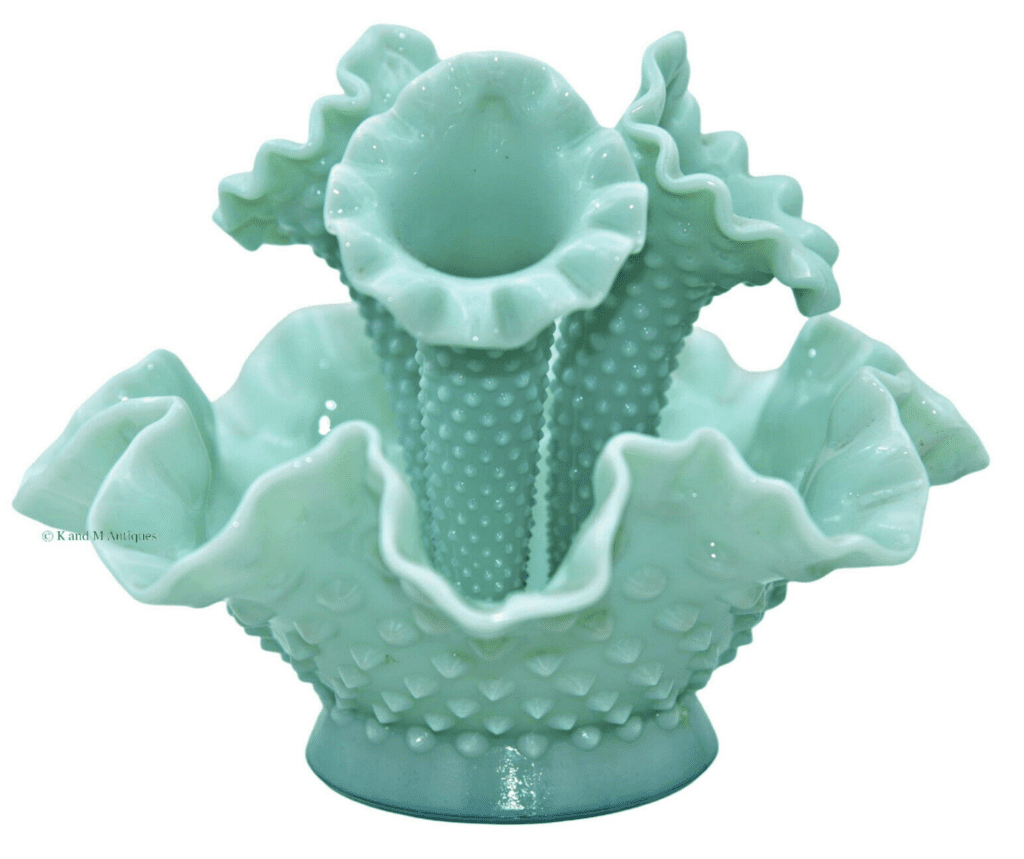
Nowadays, Fenton Glass continues to be popular, though more so among antique collectors than anyone else. During their periods of high popularity, they produced some timeless works that will continue to be popular among collectors for the foreseeable future.
Frequently Asked Questions about Fenton Glass
Is Fenton Glass uranium glass?
Fenton Glass can be radioactive if it falls into a certain category. In the early 20th century, uranium was a common material used in making what is now known as Vaseline glass or Uranium Glass. Vaseline glass got its name for the color it produces, which can appear similar to the color of Vaseline. Colors can range from a canary yellow to a muted green.
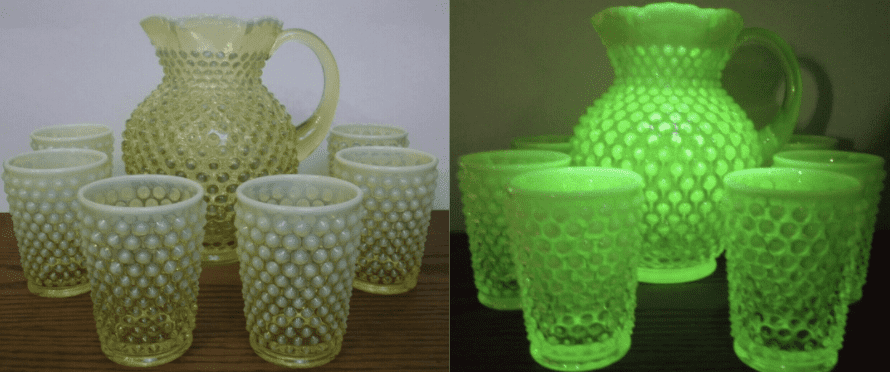
Though Vaseline glass is not particularly plentiful, it was not rare for it to be produced until the 1940s, when uranium became critical for the war effort (hello, Manhattan Project). By the time it became less critical for the war, better recipes for glass-making had been produced, as well as further understanding concerning the dangers of radioactivity.
Is Fenton Glass radioactive?
The types of Fenton Glass that contain uranium are technically radioactive. So should you be worried about radiation if you come across Vaseline glass? Most of the research done for this article would say no. The amount of radiation that you would experience from Vaseline glass is so infinitesimal that you would experience more radiation from eating a banana than from drinking out of a Vaseline glass.
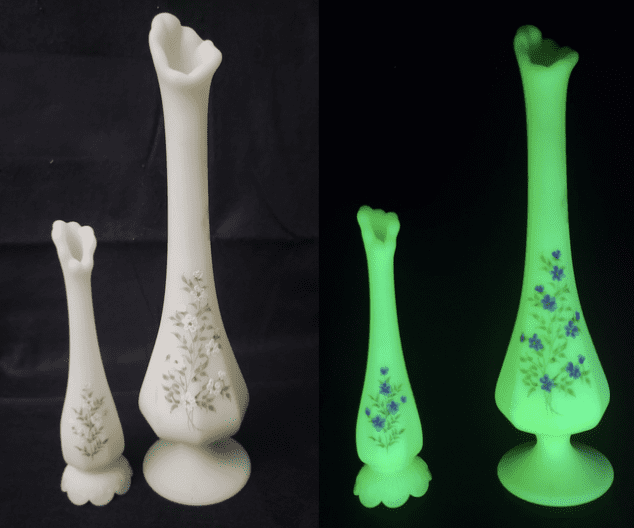
from AlleyCatsCurioShop on Etsy
Most agree that the lead used in early glass recipes poses more of a threat than radioactivity from uranium. Again, though not present in all recipes, it was not uncommon for lead to be used in glassmaking during this time. It is possible to use glass made with lead, as it takes some time for the lead to latch onto the liquid and become dangerous, but we’d recommend extreme caution if you suspect a piece to be made with lead, and to simply avoid using it, as this is the safer option.
Is Fenton Glass handblown?
Yes and no. Fenton is well-known for being a producer of handmade glass products; however, “handmade” in this sense can refer to the decorating of the glass. Fenton glass could either be handblown or pressed, which is when molten glass is pressed into a mold. Although these molds may have been crafted by hand, pressed glass is not technically handblown.
Fenton was renowned for continuing to produce handmade glass throughout the twentieth century. This may have referred to their hand-painted products or the fact that their molds/presses were made by hand. While they might have produced a certain amount of handblown glass, they produced much more pressed glass than handblown glass.

The difference between handblown and handmade may seem insignificant, but keep in mind that handblown glass tends to be much more expensive than handmade glass. Some of Fenton’s pieces were handblown, though these are (as ever) less common. Fenton’s reputation for handmade glassware is due as much to its hand decorations as anything else.
Is Fenton Glass molded?
This is very similar to the question above. Molded glass and pressed glass mean basically the same thing. Although the molds and the glass may have been pressed by hand, any type of molded or pressed glass is not technically handblown. Most Fenton Glass was molded or pressed, not handblown.
Is Fenton Glass depression glass?
The term “depression glass” can be a little ambiguous. The term comes from glass that was made during the Great Depression period (from the late 1920s until the early 1940s) that was inexpensive and usually came in translucent colors like pink, yellow, green, and crystal.
Because Fenton Glass operated during the period of the Great Depression, it is extremely likely that they made depression glass. However, there is no clear record or answer stating that Fenton ever made depression glass. If you Google “Fenton depression glass,” you will get many results for pieces of Fenton depression glass that you can buy, and they appear just like other kinds of depression glass. Although not crystal clear, it is likely that Fenton made depression glass.

